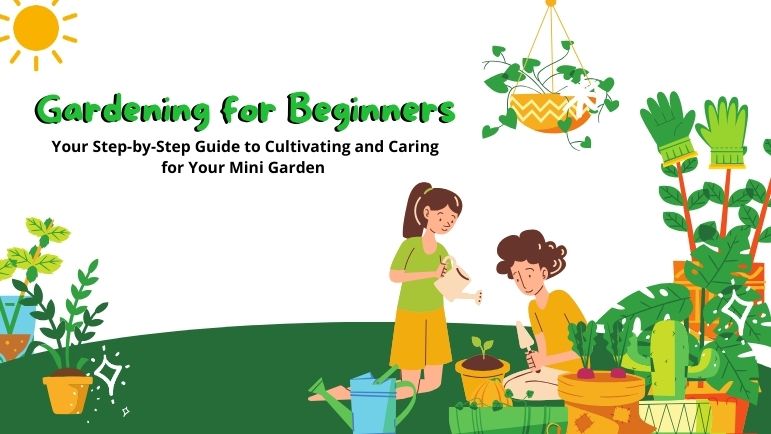Gardening For Beginners

Introduction
Gardening is not only a rewarding and enjoyable hobby, but it also teaches valuable lessons about patience, responsibility, and the wonders of nature. In the context of our changing world, with the looming challenges of global warming, cultivating a garden becomes even more significant. Whether you’re a seasoned green thumb or a beginner looking to start your own garden, this step-by-step guide will provide you with all the essential information you need to create and nurture your own little garden. Let’s dive in and explore the world of gardening!
Step 1: Choosing the Right Location
The success of your garden begins with selecting the right location. Choose a spot that receives ample sunlight, ideally 6-8 hours a day. This will ensure that your plants receive the energy they need for photosynthesis and healthy growth. Additionally, make sure the chosen area has good drainage to prevent waterlogging. Understanding and adapting to your local climate, considering the impact of global warming, will be crucial in this step.
Step 2: Planning and Designing Your Garden
Before you start planting, take some time to plan and design your garden layout. Decide what types of plants you want to grow and how much space each plant requires. Consider arranging plants based on their growth height to prevent shading and ensure everyone gets enough sunlight. This thoughtful planning also contributes to sustainability and resource efficiency, addressing the environmental implications of gardening.
Step 3: Preparing the Soil
Healthy soil is the foundation of a successful garden. Test your soil’s pH and nutrient levels and amend it accordingly. Mix in compost or well-rotted organic matter to improve soil structure, fertility, and water retention. By prioritizing soil health, you contribute to carbon sequestration, a small but impactful way to combat global warming.
Step 4: Selecting the Right Plants
Choose plants that are suitable for your climate and growing conditions. Opt for a mix of vegetables, herbs, flowers, and perhaps even a small fruit plant or two. This diversity not only adds visual appeal but can also support beneficial insects and pollinators, contributing to the overall biodiversity that is essential in the face of environmental challenges.
Step 5: Planting
Follow the planting guidelines provided on the seed packets or plant labels. Generally, you’ll want to dig a hole slightly larger than the plant’s root ball, gently place the plant in the hole, and backfill with soil. Water the newly planted seedlings thoroughly to help them settle in, taking into account water conservation practices to address the broader concerns of global water scarcity.
Step 6: Watering
Proper watering is essential for plant growth. Water your garden early in the morning or in the evening to reduce evaporation. Aim to keep the soil consistently moist but not waterlogged. Use a soaker hose or drip irrigation to target the root zone directly, minimizing water wastage.
Step 7: Mulching
Mulching helps retain soil moisture, suppress weeds, and regulate soil temperature. Apply a layer of organic mulch, such as straw or wood chips, around your plants. This also contributes to the overall aesthetic of your garden while promoting water conservation and minimizing the heat island effect associated with urban areas.
Step 8: Maintenance and Care
Regular maintenance is key to a thriving garden. Monitor for pests and diseases and address them promptly using organic methods if possible. Prune dead or diseased plant parts to encourage healthy growth. Regularly deadhead flowers to promote new blooms, fostering a resilient and self-sustaining garden ecosystem.
Step 9: Harvesting
One of the most rewarding aspects of gardening is enjoying the fruits of your labor. Harvest vegetables, herbs, and flowers at their peak to enjoy the best flavor and appearance. Remember to research the best practices for harvesting each plant type, contributing to the reduction of your ecological footprint through mindful consumption.
Step 10: Continuous Learning
Gardening is an ongoing learning experience. Keep a gardening journal to record your successes, challenges, and observations. Join online gardening forums or local gardening clubs to connect with other enthusiasts and exchange tips. Stay informed about sustainable and climate-resilient gardening practices, adapting your approach in response to the evolving realities of our planet.
Conclusion
Embarking on the journey of creating your own little garden can be an incredibly fulfilling experience, especially when viewed through the lens of global warming and environmental stewardship. From selecting plants to nurturing them and watching them flourish, gardening offers a connection to the natural world that is truly unique. By following this step-by-step guide, you’ll be well-equipped to turn your gardening aspirations into a vibrant and thriving reality, all while contributing to a more sustainable and resilient future. Happy gardening!
